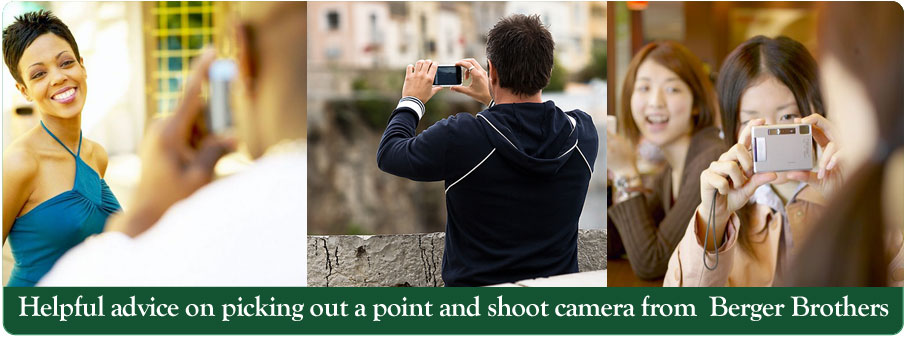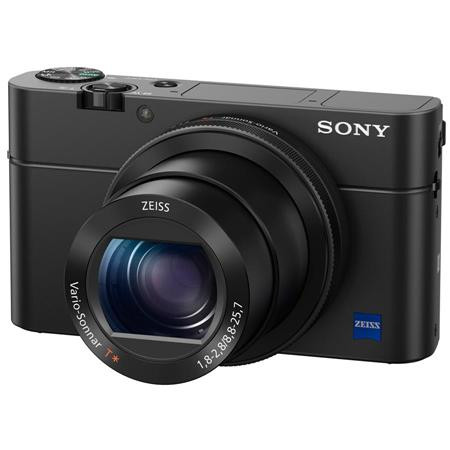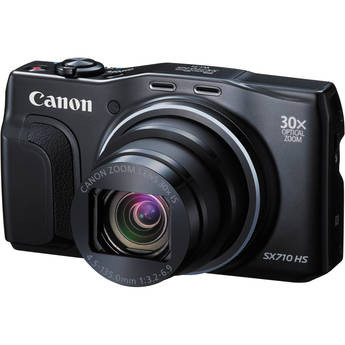There are no products listed under this category.
Choosing a Point & Shoot Camera
 |
Recommended Point & Shoot Cameras: |
||||
 |
 |
 |
 |
 |
Basic Camera FeaturesThere are a bewildering amount of features available for digital cameras, so which compact camera is the best compact camera for you? Even the most inexpensive camera will probably be quite feature rich. The important thing is to make sure the camera you purchase has the features you need. The mysteries of megapixelsThe size of the image your camera creates is measured in megapixels. If all you want is to create prints directly from your images, an eight megapixel camera, such as the Olympus FE-350 will probably work just fine. Eight megapixels can provide prints up to 16x20 inches. But why stop there? Editing your image, either on a computer or within the camera itself is now easier than ever. If this is of interest to you, then you might want to zoom in on a certain part of the existing image. Doing that requires more megapixels, so if you want to move into digital editing, eight, ten or twelve megapixels, which you'll find on the Pentax X70 and other models doesn't hurt one bit. Asking the pros at Berger Brothers is an excellent way of finding out which compact camera has the megapixels you need. Setting the scene: Viewfinders versus LCD monitorsSimply put, a viewfinder is the device found on traditional cameras that you look through to compose your photograph. An LCD monitor is the plastic monitor on the back of the camera used for the same purpose, that you see on most digital cameras today. In addition, the LCD screen is used to review photos and in some cases, display your camera's settings. Obviously the larger and brighter the screen the better. One of the main drawbacks of the LCD monitor is it can be hard to see in bright sunlight. Some cameras compensate for this by having a monitor that swivels or rotates (also useful for taking photos of yourself). Also helpful is a camera which combines an LCD monitor and a viewfinder, like the Canon PowerShot SC10, so that you might use the viewfinder in bright light situations. Let there be lightMost cameras come equipped with some sort of flash. One of the drawbacks of flash photography is red eye - the effect of having the subject's eyes turn red when using a flash. Many cameras, including the SONY DSC-H20 have a flash that operates in red eye mode to take care of this problem. In addition, a pop-up flash will be more effective at removing red eye than one built into the body of the camera. Many people don't like the look of flash photos, particularly when shooting people. If you're one of those people, you might consider getting a camera which is capable of using an external flash, such as the Nikon Coolpix P6000. Set it and forget itToday's best point and shoot cameras come with a wealth of automatic settings. You'll find in most cases, functions such as focusing and exposure can be done quite well by the camera, freeing you to concentrate on composing the photo. In addition, most cameras, like the Fujifilm FinePix J10 have specific automatic modes, such as portrait, close-up or macro photography, landscapes, night photography and many more. One of the best new features is automatic face detection technology, that automatically adjusts exposure and color to make faces look their best, such as can be found on the Sony Cybershot DSC-T900. And yet there are times with even the best point and shoot cameras, when automatic settings don't work - perhaps there isn't enough light for the camera to focus, perhaps action is too fast for the camera to keep up with. In those cases, having some manual control of the camera can be a life-saver. One such option is a camera such as the Leica D-LUX 4 which allows you to control every aspect of the shot manually. Another feature to look for when selecting a camera with auto-focus is a focus assist lamp, such as can be found on the Panasonic Lumix DMCLX3. This feature allows the camera to focus more precisely and quickly in low light situations. |
The best small camera to get closer to the action?There are two types of zoom, optical and digital. It's best to stay away from a compact zoom camera which provides only a digital zoom. A basic range for an optical zoom lens is 3x or 4x. Some of the best compact cameras, such as the Nikon Coolpix P600 comes with a built in 4x wide angle lens in addition to a zoom. At the other end of the spectrum, a camera like the Olympus SP-590 UZ has a 26x wide angle/zoom lens which works amazingly well, particularly in well lit subjects. Keep in mind though, that when shooting with higher than 5x zoom, such as the Canon PowerShot SX200IS 12x zoom, image stabilization is mandatory. How to keep away the shakes with a compact zoom cameraWhen taking a photo in a low light situation, the shutter must remain open longer than in bright light. This means more time for the natural shaking of the hands to cause blurring. Blurring can also be caused by shooting with your camera zoomed in on a subject, or taking a photo of something in motion. Optical image stabilization can reduce the blurring which occurs in these situations. Using your telephoto lens only in well lit situations, and a camera such as the Nikon Coolpix S620 which has four way optical image stabilization for a variety of situations can help you get the shot in low light situations without resorting to using your flash. The card: Storing your images inside your cameraDigital cameras use replaceable memory cards for storing images, created by point and shoot photography. Depending on the megapixels of the camera, and what kind of compression you are using, you might get between 85 and 350 images on a card. If you value the number of images you can fit on a card over the quality, look for a camera which has variable quality settings for the image, such as the Nikon Coolpix L19. Cards come with a variety of storage space, from a few megabytes to several gigabytes, capable of storing hundreds of JPEG images on the best compact cameras. Compression reduces the size of the image file by eliminating extra data from the image and saving it in JPEG format, which typically provides for great looking photos with a minimum of graininess. For full control, shoot in RAW format. RAW keeps all the image data intact. The drawback is that the file size is much larger, resulting in fewer images on your card. In addition, the image must then be processed on a computer before it can be printed or used electronically. The advantage is that you have much more flexibility in editing your image on your computer. You can adjust exposure, color and light, as well as eliminate more noise. Most point and shoot digital cameras which shoot in RAW format, such as the Fujifilm FinePix S100fs, also allow you to shoot in JPG format, or in some cases, allows you to shoot both at the same time. Lights, camera, action!Many of today's digital point and shoot cameras also allow you to shoot videos. Some, like the Canon PowerShot SX1IS even allows you to shoot full HD videos. Compare compact cameras sold by Berger Brothers and you'll find a variety of useful features to help you create stunning video.The compact camera ratings are in ... And the best pocket camera is determined by who will be using it, and what they want to shoot. Point and shoot photography has come a long ways, and todays cameras are capable of producing professional results. The professionals at Berger Brothers Camera will be happy to help you compare compact cameras, and decide which point and shoot best suits your needs. |
